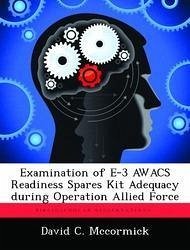This report reviews the critical importance of E-3 aircraft in today's air operations, examines the supply concept for deployed aircraft packages, and assesses the adequacy of deployed E-3 AWACS readiness spares kits during Operation ALLIED FORCE. Also, FY 1999 summary readiness indicator statistics for the E-3 fleet, at different deployed locations and home station, before, during, and after ALLIED FORCE are presented. Recent E3 spares shortages in other deployed operations have prompted senior leadership to consider spares adequacy issues force wide. Additionally, the annual E-3 RSP review process is considered, with a focus on understanding how the new concept of agile logistics and depot EXPRESS initiatives have impacted E-3 readiness. Cost trends in E-3 RSP kit configuration are presented, along with a discussion of various recent top-ten MICAP problem parts. The author concludes that extraordinarily high E-3 mission capable rates achieved during the 78-day ALLIED FORCE air operation were primarily due to opportune logistical support from the NATO E-3 base of Geilenkirchen rather than deployed E-3 RSPs. During the conflict's limited timeframe, nearly 200 reparable parts were borrowed from our NATO allies to solve E-3 MICAP situations as initial communication and logistical delays hampered U.S. resupply efforts. Finally, the author observes that recent initiatives to increase spares inventories through increased funding are likely to raise E-3 mission capable rates.








